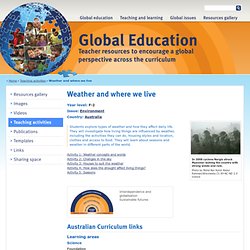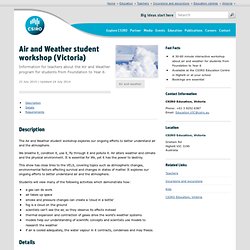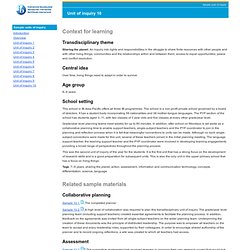

Weather and where we live. Learning areas Science Foundation Daily and seasonal changes in our environment, including the weather, affect everyday life (ACSSU004) Year 1 Living things live in different places where their needs are met (ACSSU211) Observable changes occur in the sky and landscape (ACSSU019) Year 2 People use science in their daily lives, including when caring for their environment and living things (ACSHE035) Geography The representation of the location of places and their features on maps and a globe (ACHGK001) The weather and seasons of places and the ways in which different cultural groups, including Aboriginal and Torres Strait Islander Peoples, describe them (ACHGK006) Collect and record geographical data and information, for example, by observing, by interviewing, or from sources such as, photographs, plans, satellite images, story books and films (ACHGS014) General capabilities.

Weather unit.pdf. 01weather.pdf. Weather and Climate: Unit Outlines — Weather and Climate: From Home to the Poles. Summary of Purpose for the Unit This unit was designed to introduce primary students to weather vocabulary and develop their abilities to make observations and record data.

It uses firsthand experience, data, and text to answer these questions: How does the weather change over time? How can we talk about changes in the weather? Standards Alignment National Science Education Standards: Science Content Standards Science content standards are found in Chapter 6 of the National Science Education Standards.
Science as Inquiry (Grades K-4) Ask questions about objects, organisms, and events in the environmentEmploy simple equipment and tools to gather data and extend the sensesUse data to construct a reasonable explanationCommunicate investigations and explanations Earth and Space Science (Grades K-4) Changes in the Earth and Sky IRA/NCTE Standards for the English Language Arts View the standards at 1 - Students read a wide range of print and nonprint texts. Unit Outline Engage Explore Explain Expand Assess. Get_file. Living vs. Nonliving. In this lesson, students learn about the characteristics that distinguish living things from nonliving things.

By examining video clips and still photographs of a variety of objects and organisms, students gather evidence and develop criteria to decide if something is living or nonliving. This lesson is appropriate for students in all elementary grades. Use these resources to create a simple assessment or video-based assignment with the Lesson Builder tool on PBS LearningMedia. Young children often have difficulty characterizing things as living or nonliving.
For example, they tend to describe anything that moves as alive. 1. 2. What are some characteristics of living things? Write all ideas down. 3. 4. K.2_living_and_non_living_inquiry.pdf. Education programs at bureau of meteorology. Primescieducation.pdf. Air and Weather student workshop (Victoria) Information for teachers about the Air and Weather program for students from Foundation to Year 6. 23 July 2010 | Updated 24 July 2014 Description The Air and Weather student workshop explores our ongoing efforts to better understand air and the atmosphere.

We breathe it, condition it, use it, fly through it and pollute it. Air alters weather and climate and the physical environment. This show has close links to the VELS, covering topics such as atmospheric changes, environmental factors affecting survival and changes in states of matter. Students will view many of the following activities which demonstrate how: Details This session is suitable for students from Foundation to Year 6: Foundation to Year 2 the session runs for 30 minutes Years 3 to 6 the session runs for 60 minutes. Bookings are essential. For students from Foundation to Year 2 the costs are: For Years 3-6 the costs are: * A reduced minimum cost per day will apply for second and subsequent days Requirements. Prep unit overview — Australian Curriculum: Science. Sample units of inquiry. Context for learning Transdisciplinary theme Sharing the planet: An inquiry into rights and responsibilities in the struggle to share finite resources with other people and with other living things; communities and the relationships within and between them; access to equal opportunities; peace and conflict resolution.

Central idea Over time, living things need to adapt in order to survive. Age group 8–9 years School setting This school in IB Asia-Pacific offers all three IB programmes. Grade/year level planning teams meet weekly for up to 80 minutes. This was the second unit of inquiry of the year for the students. Tags: 7–9 years, sharing the planet, action, assessment, information and communication technology, concepts, differentiation, science, language Related sample materials Collaborative planning Sample 10.1 The completed planner Sample 10.2 A high level of collaboration was required to plan this transdisciplinary unit of inquiry.
Assessment Sample 10.3 Concepts Sample 10.4 Sample 10.5 Resources.